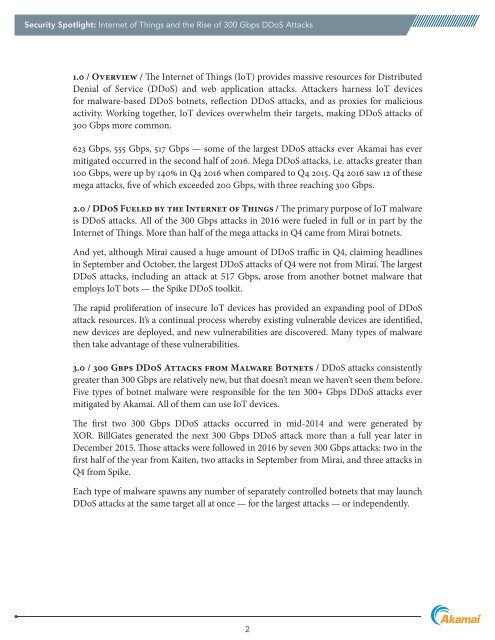You also want an ePaper? Increase the reach of your titles
YUMPU automatically turns print PDFs into web optimized ePapers that Google loves.
Security Spotlight: <strong>Internet</strong> <strong>of</strong> <strong>Things</strong> <strong>and</strong> <strong>the</strong> <strong>Rise</strong> <strong>of</strong> <strong>300</strong> <strong>Gbps</strong> <strong>DDoS</strong> <strong>Attacks</strong><br />
1.0 / Overview / The <strong>Internet</strong> <strong>of</strong> <strong>Things</strong> (IoT) provides massive resources for Distributed<br />
Denial <strong>of</strong> Service (<strong>DDoS</strong>) <strong>and</strong> web application attacks. Attackers harness IoT devices<br />
for malware-based <strong>DDoS</strong> botnets, reflection <strong>DDoS</strong> attacks, <strong>and</strong> as proxies for malicious<br />
activity. Working toge<strong>the</strong>r, IoT devices overwhelm <strong>the</strong>ir targets, making <strong>DDoS</strong> attacks <strong>of</strong><br />
<strong>300</strong> <strong>Gbps</strong> more common.<br />
623 <strong>Gbps</strong>, 555 <strong>Gbps</strong>, 517 <strong>Gbps</strong> — some <strong>of</strong> <strong>the</strong> largest <strong>DDoS</strong> attacks ever Akamai has ever<br />
mitigated occurred in <strong>the</strong> second half <strong>of</strong> 2016. Mega <strong>DDoS</strong> attacks, i.e. attacks greater than<br />
100 <strong>Gbps</strong>, were up by 140% in Q4 2016 when compared to Q4 2015. Q4 2016 saw 12 <strong>of</strong> <strong>the</strong>se<br />
mega attacks, five <strong>of</strong> which exceeded 200 <strong>Gbps</strong>, with three reaching <strong>300</strong> <strong>Gbps</strong>.<br />
2.0 / <strong>DDoS</strong> Fueled by <strong>the</strong> <strong>Internet</strong> <strong>of</strong> <strong>Things</strong> / The primary purpose <strong>of</strong> IoT malware<br />
is <strong>DDoS</strong> attacks. All <strong>of</strong> <strong>the</strong> <strong>300</strong> <strong>Gbps</strong> attacks in 2016 were fueled in full or in part by <strong>the</strong><br />
<strong>Internet</strong> <strong>of</strong> <strong>Things</strong>. More than half <strong>of</strong> <strong>the</strong> mega attacks in Q4 came from Mirai botnets.<br />
And yet, although Mirai caused a huge amount <strong>of</strong> <strong>DDoS</strong> traffic in Q4, claiming headlines<br />
in September <strong>and</strong> October, <strong>the</strong> largest <strong>DDoS</strong> attacks <strong>of</strong> Q4 were not from Mirai. The largest<br />
<strong>DDoS</strong> attacks, including an attack at 517 <strong>Gbps</strong>, arose from ano<strong>the</strong>r botnet malware that<br />
employs IoT bots — <strong>the</strong> Spike <strong>DDoS</strong> toolkit.<br />
The rapid proliferation <strong>of</strong> insecure IoT devices has provided an exp<strong>and</strong>ing pool <strong>of</strong> <strong>DDoS</strong><br />
attack resources. It’s a continual process whereby existing vulnerable devices are identified,<br />
new devices are deployed, <strong>and</strong> new vulnerabilities are discovered. Many types <strong>of</strong> malware<br />
<strong>the</strong>n take advantage <strong>of</strong> <strong>the</strong>se vulnerabilities.<br />
3.0 / <strong>300</strong> <strong>Gbps</strong> <strong>DDoS</strong> <strong>Attacks</strong> from Malware Botnets / <strong>DDoS</strong> attacks consistently<br />
greater than <strong>300</strong> <strong>Gbps</strong> are relatively new, but that doesn’t mean we haven’t seen <strong>the</strong>m before.<br />
Five types <strong>of</strong> botnet malware were responsible for <strong>the</strong> ten <strong>300</strong>+ <strong>Gbps</strong> <strong>DDoS</strong> attacks ever<br />
mitigated by Akamai. All <strong>of</strong> <strong>the</strong>m can use IoT devices.<br />
The first two <strong>300</strong> <strong>Gbps</strong> <strong>DDoS</strong> attacks occurred in mid-2014 <strong>and</strong> were generated by<br />
XOR. BillGates generated <strong>the</strong> next <strong>300</strong> <strong>Gbps</strong> <strong>DDoS</strong> attack more than a full year later in<br />
December 2015. Those attacks were followed in 2016 by seven <strong>300</strong> <strong>Gbps</strong> attacks: two in <strong>the</strong><br />
first half <strong>of</strong> <strong>the</strong> year from Kaiten, two attacks in September from Mirai, <strong>and</strong> three attacks in<br />
Q4 from Spike.<br />
Each type <strong>of</strong> malware spawns any number <strong>of</strong> separately controlled botnets that may launch<br />
<strong>DDoS</strong> attacks at <strong>the</strong> same target all at once — for <strong>the</strong> largest attacks — or independently.<br />
2


